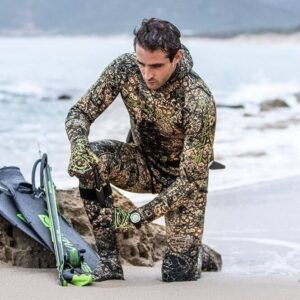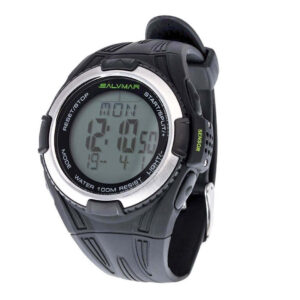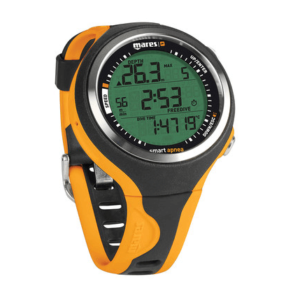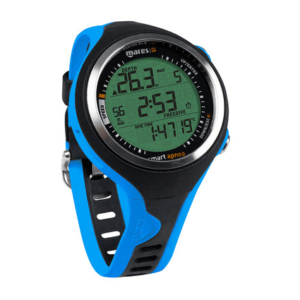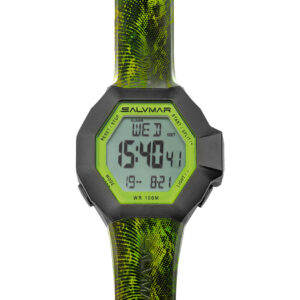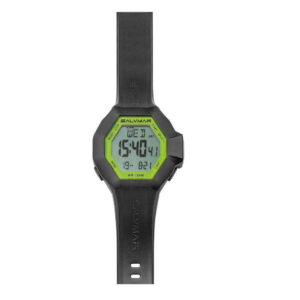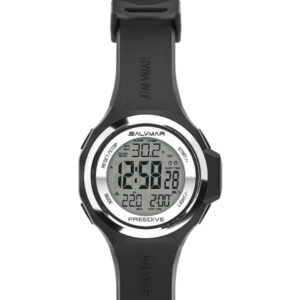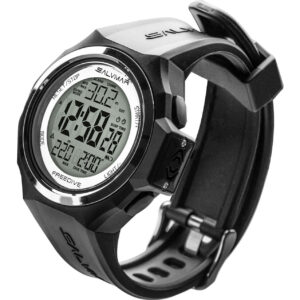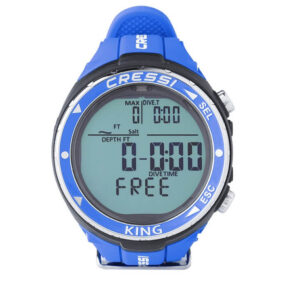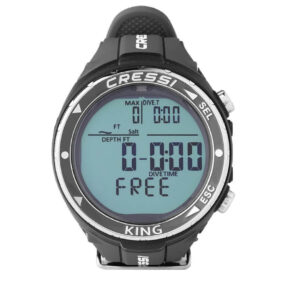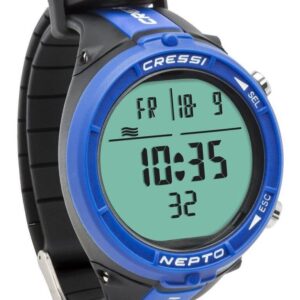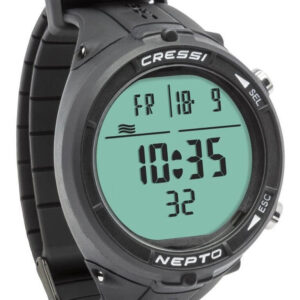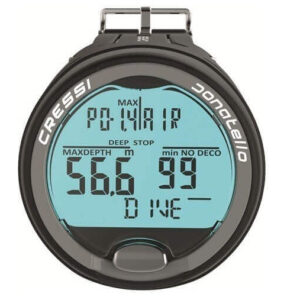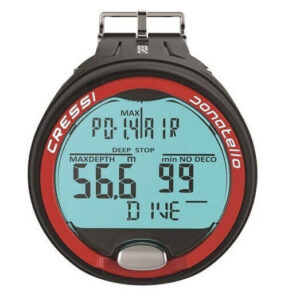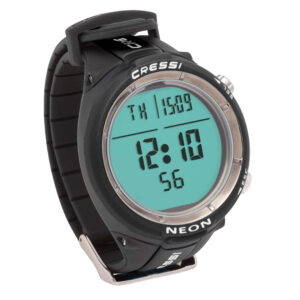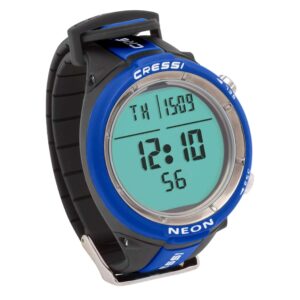Diving watches
Shop from our extensive range of diving watches, each loaded with a whole range of essential features for spearfishing, freediving, scuba or swimming.
Click here for our diving watch buy guide.
Showing all 8 resultsSorted by latest
Diving watch buy guide
Our dive watches come with a whole range of features. The one you choose will depend on what you want to use the watch for : spearfishing, freediving (apnea/apnoea), scuba, swimming or perhaps all four. In this guide we’ll explain the features to look for on our diving watches and why they are useful, or sometimes essential. If you have any questions at all, please do ask our shop team!
Depth gauge
A depth gauge is essential for divers for a range of reasons. Whenever you freedive, you’ll have a planned depth limit and the depth gauge will tell you how close you are to this.
Most freedivers will dive no more than 12 – 18 metres and you will need good physical fitness and training to get to this depth. It is not essential to dive so deep when spearfishing as there is plenty to catch at depths where you can still stand up!
Even if you plan to dive deeper, you’ll be doing warm-up dives first that help you avoid hemoptysis and pulmonary edema and the depth gauge is essential to monitor these. The Cressi King has a specific Blood Shift function setting for this purpose.
When you scuba dive you may be limited by your diving certification (i.e. 18, 30 or 40+ metres), gas mix, insurance, limits of your equipment or perhaps your dive school/instructor’s own rules.
The physical conditions of your dive spot such as water temperature, visibility, and current may also influence how far you can deeply dive.
Our diving watches typically have a depth gauge of 100 – 150 metres which is more than adequate for the vast majority of dives.
Fun fact – the world record for the deepest dive is currently held by Petar Klovar of Croatia in 2023 (128 metres).
Dive timer
The dive timer is another must-have on a diving watch. It is an essential time-keeping tool to track the duration of your dive, primarily for safety reasons.
It helps you keep tabs on how long you’ve been underwater so you can spend adequate time above the surface in between (also see interval timer below). It also allows you to monitor your overall dive time as part of safety measures to avoid taravana – the risk is increased for long dive times.
For scuba divers, it helps with dive planning, such as planning decompression stops and monitoring air consumption rates.
Many diving organisations also require that dive time is logged, both for compliance and verification for certification.
Surface interval timer
Having a safe surface interval is the most important thing to consider for freedivers and spearfishing, and keeping your self calm and comfortable.
Ideally divers should be spending at least twice the dive time on the surface before diving again. For example, if you dive for 1 minute, aim to spend 2 minutes on the surface before diving again.
Having a nice slow surface interval at least two minutes of calm breathing to lower your heart rate is the number one thing which will help stop black outs or stop you from pushing yourself.
Some diving watches such as the Salvimar One and the Cressi Donatello automatically calculate this for you. As soon as you get to the surface, a stopwatch is activated to show you how long you have been topside.
Water temperature
Tracking water temperature with a dive watch is useful for a number of reasons. Firstly, it’s needed for safety and planning. If it’s particularly cold, you’ll know your time will be limited in the water, taking into account the thickness of your wetsuit. You can also take into account other members of your group who may be more impacted by the cold.
Awareness that the water is colder helps you anticipate that you and your group may become more tired more quickly, and may have less dexterity.
For scuba divers, the cold affects Nitrogen Absorption Rates and you may need to adjust your dive profile and safety stops to account for this.
Diving watches cope with a wide range of temperatures – a typical range for a watch would be -10 to 50 c (or 14f to 122f).
Descent and ascent rate
Descending too quickly can cause ear and sinus problems – having a monitor can help you descend at your own individual comfort level.
For scuba divers, controlling the rate at which you ascend helps avoid ‘the bends’, and helps you correctly plan decompression stops.
Alarms
Gauges are all very well if you look at them but you can become quickly distracted and may miss a crucial reading. That’s where having a range of alarms is really useful.
Typical alarms on a dive watch include –
- Max diving depth
- Max diving time
- Depth
- Speed
- Hydration
- Recovery time
These are all crucial readings for safety and to minimise the chance of taravana.
Some allow intermediate alarms, so rather than just have one max depth which creeps up on you, you can have markers along the way.
The Cressi King has a specific taravana alarm setting. This is not only measuring surface interval time but also takes into account the depth and total time of your previous dive and the water temperature.

Desaturation time
For scuba divers, this measures the period required for the nitrogen absorbed into a diver’s body during a dive to be released to safe levels. The longer and deeper the dive, the more nitrogen is absorbed, and the longer the desaturation period required. The dive watch notifies divers when it’s safe to dive again.
No fly time
Another feature for scuba divers and freedivers who have done multiple deep dives is the no-fly time. This is the minimum recommended time that divers should wait before flying after diving.
If you fly too soon after diving, you can get decompression sickness because of the reduced atmospheric pressure in aircraft cabins, which leads to the nitrogen still dissolved in the body to form bubbles. Even though freedivers don’t breathe compressed air, they still absorb nitrogen into their tissues when diving deep, where pressure is greater. So the no-fly time monitor can be useful for both types of diver.
Large numbers, backlight
These are a nice-to-have features on some of the dive watches, so you can quickly glance at your screen and see the readings, or view data even if light conditions aren’t great.
Sleep mode
Nice to have as it increases battery life.
Deactivations
Some dive watches allow you to deactivate dive functions so that they can be used for other underwater activities without annoyance (i.e.. so you don’t get alarms going off when you’re swimming or snorkelling).
Memory
This stores a certain amount of your past data. It can be used for monitoring your personal progress and planning future dives. It may also be needed for certification.
Sampling rate
This is how often the diving watch takes a reading. Typically it will be one per second or one per half second. Faster is better as the readings are more up-to-date and therefore more accurate.
Time
Most diving watches will show the actual time.
Other considerations
Some watches have been designed to be particularly compact and therefore less clunky to wear. You might also have preferences between the different styles.
Strap size is an important consideration – the Salvimar One is shorter than the Salvimar Deeper for example. We can guide you towards larger straps if this is likely to be an issue for you.
One consideration is whether the user can replace the battery themselves. This ability saves taking the watch to a watch shop and paying that extra cost.
Finally the availability of accessories may be a consideration – such as silicone screen protectors which are great for minimising scratches and magnifying the display.

